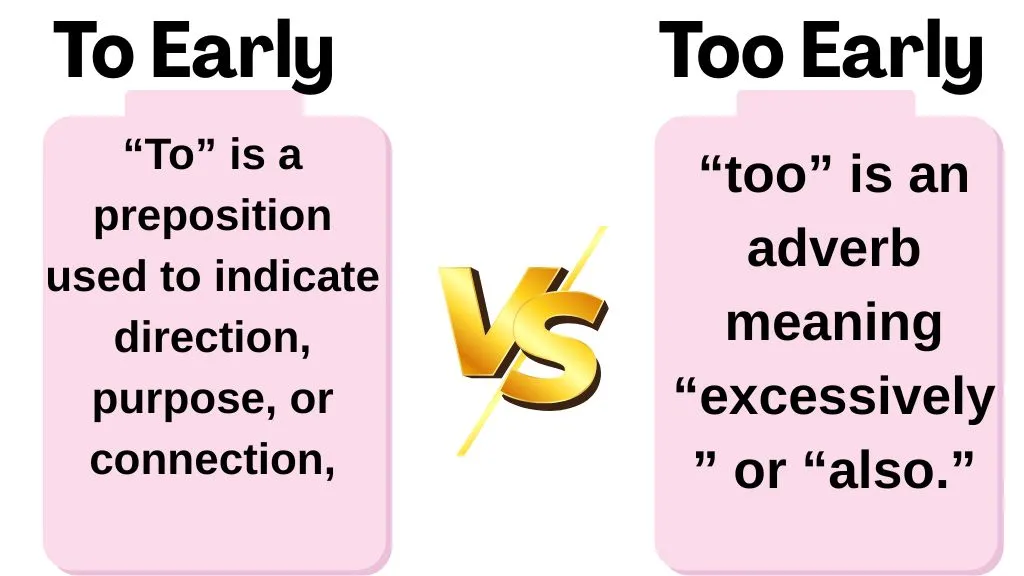Last updated on April 19th, 2025 at 02:44 pm
English is full of words that sound the same but have entirely different meanings and uses.
A classic example is the confusion between to and too. Both words are short, simple, and easy to misuse, especially in phrases like “too early” or “to early.”
This comprehensive guide will help you understand the distinction between these words, clarify their correct usage, and avoid common mistakes.
Deciphering “To” vs. “Too”: Common Confusions Clarified

At first glance, to and too may appear interchangeable due to their similar pronunciation. However, their meanings and grammatical roles couldn’t be more distinct.
What Does “To” Mean?
To is a preposition or part of an infinitive verb phrase. It often indicates direction, purpose, or a relationship between words.
- Example in Direction: “We are going to the park.”
- Example in Purpose: “He wants to learn Spanish.”
What Does “Too” Mean?
Too is an adverb that modifies adjectives or other adverbs. It generally means “excessively” or “also.”
- Example as Excess: “It’s too hot outside.”
- Example as Also: “I’d like some coffee too.”
Key Difference: To serves functional purposes like indicating direction, while too emphasizes or adds to a statement.
Is it “to early” or “too early”? These two tiny words cause big confusion in English grammar. Discover their meanings, differences, and how to use them correctly with examples and tips!
Examples in Context: When to Use “Too Early” in a Sentence
The phrase too early is commonly used to describe situations where something happens prematurely or before an appropriate time. Here are some examples:
- Daily Life:
- “It’s too early to start planting flowers in the garden.”
- “We arrived too early at the airport and had to wait for hours.”
- Professional Contexts:
- “It’s too early to release the product without further testing.”
- “The project was canceled because it was deemed too early for market readiness.”
- Social Settings:
- “Don’t wake her up—it’s too early.”
- “Is it too early to celebrate the victory?”
Common Errors
- Incorrect: “It’s to early to tell if the plan will succeed.”
- Correct: “It’s too early to tell if the plan will succeed.”
Using too early correctly is essential to convey a sense of excess or prematurity.
Understanding Intensifiers: The Role of “Too” in English
In English, too functions as an intensifier, amplifying the meaning of an adjective or adverb.
How “Too” Works as an Intensifier
- It adds emphasis to a negative or undesirable quality.
Example: “This box is too heavy to lift.” - It shows an extent beyond what is acceptable or ideal.
Example: “It’s too late to make changes now.”
Comparing Intensifiers
| Intensifier | Function | Example |
|---|---|---|
| Too | Indicates excess | “It’s too cold to go outside.” |
| Very | Adds emphasis without excess | “The soup is very tasty.” |
| So | Suggests cause and effect | “She was so tired that she fell asleep.” |
Understanding the role of too helps clarify its unique meaning compared to other intensifiers.
Mistakes to Avoid: Tips for Remembering the Difference
Even native English speakers occasionally confuse to and too. Here are some tips to help you avoid common mistakes:
- Check the Context:
If you’re indicating excess or addition, use too. If you’re showing direction or purpose, use to.
Example:- “It’s too early for dinner.” (Excess)
- “I’m heading to the kitchen.” (Direction)
- Mnemonic Device:
Remember, too means “also” or “excessively.” The extra “o” in too can remind you of the idea of “more.” - Proofread:
Reread sentences to ensure you’ve chosen the correct word. If in doubt, try replacing to with “toward” or too with “also” to test the sentence’s meaning.
The Nuances of English Prepositions: Using “To” Correctly
To is one of the most versatile prepositions in English, used in a variety of contexts. Understanding its nuances will improve your grammar and clarity.
Key Uses of “To”
- Direction or Destination:
Example: “He’s going to the store.” - Infinitive Verbs:
Example: “She wants to dance.” - Comparison or Connection:
Example: “I prefer tea to coffee.” - Expressions of Time:
Example: “It’s quarter to eight.”
Common Phrases with “To”
| Phrase | Meaning | Example |
|---|---|---|
| To and fro | Back and forth movement | “The boat rocked to and fro.” |
| To the point | Relevant or concise | “Her argument was straight to the point.” |
| To no avail | Without success | “He tried to fix it, but to no avail.” |
Prepositions in Action: Practical Usage of “To”
Prepositions can be tricky because their meanings often depend on context. Let’s look at to in different scenarios.
- Travel and Movement:
- “She walked to the park.” (Destination)
- “They flew to Paris for their vacation.” (Direction)
- Communication:
- “Please explain this to me.” (Recipient)
- “He wrote a letter to his grandmother.” (Direction of action)
- Purpose or Intention:
- “He exercises to stay healthy.” (Purpose)
- “She donated to help the community.” (Intention)
Expert Insights: Grammar Authorities Weigh in on “To” and “Too”
Many grammar experts emphasize the importance of understanding the unique roles of to and too to improve clarity in writing and speech.
A Quote from Grammar Guru Patricia O’Conner
“In English, prepositions like ‘to’ may seem small, but their impact is immense. Proper use elevates communication from average to precise.”
From Oxford English Dictionary
“The word ‘too’ serves as an essential intensifier, giving sentences additional weight or emotion. Mastering its use is key to fluency.”
Practical Advice from Linguists
- Practice writing sentences using both to and too.
- Rely on examples and context to guide usage.
FAQs
Is it “to early” or “too early”?
The correct phrase is “too early.” The word “too” functions as an adverb meaning “excessively,” making it the right choice for describing something happening prematurely.
What’s the difference between “to” and “too”?
“To” is a preposition used to indicate direction, purpose, or connection, while “too” is an adverb meaning “excessively” or “also.”
How do I avoid confusing “to” and “too”?
Check the context of your sentence. If you’re describing excess or addition, use “too.” If the word shows direction or purpose, use “to.”
What are examples of “too early” in a sentence?
Examples include:
- “It’s too early to tell if the plan will succeed.”
- “We woke up too early for the flight.”
Are “to” and “too” homophones?
Yes, “to” and “too” are homophones, meaning they sound the same but have different meanings and spellings, which is why they’re often confused.
What’s a quick trick to remember “too”?
The extra “o” in “too” can remind you of “more” or “excess.” For example, “too” means “more than enough” or “also.”
Conclusion
Understanding the difference between to and too is essential for clear and effective communication in English. While to serves a functional role as a preposition or part of an infinitive, too intensifies statements or adds emphasis.
By mastering their distinctions and practicing their usage, you’ll confidently avoid common mistakes.
So, next time you wonder whether it’s “to early” or “too early,” you’ll know exactly which one to choose!





